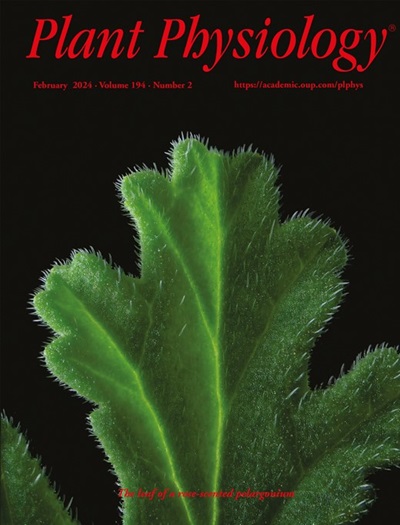N-Hydroxypipecolic acid and salicylic acid play key roles in autoimmunity induced by loss of the callose synthase PMR4
IF 6.9
1区 生物学
Q1 PLANT SCIENCES
引用次数: 0
Abstract
In Arabidopsis thaliana, the POWDERY MILDEW RESISTANT4 (PMR4)/GLUCAN SYNTHASE LIKE5 (GSL5) callose synthase is required for pathogen-induced callose deposition in cell wall defense. Paradoxically, pmr4/gsl5 mutants exhibit strong resistance to both powdery and downy mildew. The powdery mildew resistance of pmr4/gsl5 has been attributed to up-regulated salicylic acid (SA) signaling based on its dependence on PHYTOALEXIN DEFICIENT4 (PAD4), which controls SA accumulation, and its abolishment by bacterial NahG salicylate hydroxylase. Our study revealed that disruption of PMR4/GSL5 also leads to early senescence. Suppressor analysis uncovered that PAD4 and N-hydroxypipecolic acid (NHP) biosynthetic genes ABERRANT GROWTH AND DEATH2-LIKE DEFENSE RESPONSE PROTEIN1 (ALD1) and FLAVIN-DEPENDENT MONOXYGENASE1 (FMO1) are required for early senescence of pmr4/gsl5 mutants. The critical role of NHP in the early senescence of pmr4/gsl5 was supported by greatly increased accumulation of pipecolic acid in pmr4/gsl5 mutants. In contrast, disruption of the SA biosynthetic gene ISOCHORISMATE SYNTHASE1/SA-INDUCTION DIFFICIENT 2 (ICS1/SID2), which greatly reduces SA accumulation, had little effect on impaired growth of pmr4/gsl5. Furthermore, while disruption of PAD4 completely abolished the powdery mildew resistance in pmr4/gsl5, mutations in ICS1/SID2, ALD1, or FMO1 had only a minor effect on the resistance of the mutant plants. However, disruption of both ICS1/SID2 and FMO1 abolished the enhanced immunity of the callose synthase mutants against the fungal pathogen. Therefore, while NHP plays a crucial role in the early senescence of pmr4/gsl5 mutants, both SA and NHP have important roles in the strong powdery mildew resistance induced by the loss of the callose synthase.n -羟基果酸和水杨酸在胼胝质合成酶PMR4缺失引起的自身免疫中起关键作用
在拟南芥中,白粉病抗性4 (PMR4)/葡聚糖合成酶LIKE5 (GSL5)胼胝质合成酶在细胞壁防御中是病原体诱导的胼胝质沉积所必需的。矛盾的是,pmr4/gsl5突变体对白粉病和霜霉病都表现出很强的抗性。pmr4/gsl5的白粉病抗性归因于水杨酸(SA)信号的上调,这是基于其对植物alexin缺陷4 (PAD4)的依赖,该信号控制SA的积累,并被细菌NahG水杨酸羟化酶消除。我们的研究表明,PMR4/GSL5的破坏也会导致早期衰老。抑制基因分析发现,pmr4/gsl5突变体的早期衰老需要PAD4和n -羟基酚酸(NHP)生物合成基因ABERRANT GROWTH and DEATH2-LIKE DEFENSE RESPONSE PROTEIN1 (ALD1)和FLAVIN-DEPENDENT MONOXYGENASE1 (FMO1)。NHP在pmr4/gsl5早期衰老中的关键作用得到了pmr4/gsl5突变体中大量增加的果酸积累的支持。相比之下,破坏SA生物合成基因ISOCHORISMATE SYNTHASE1/SA诱导障碍2 (ICS1/SID2)可以大大减少SA积累,但对pmr4/gsl5的生长受损影响不大。此外,PAD4的破坏完全消除了pmr4/gsl5的白粉病抗性,而ICS1/SID2、ALD1或FMO1的突变对突变植株的抗性只有轻微的影响。然而,ICS1/SID2和FMO1的破坏破坏了胼胝质合酶突变体对真菌病原体的增强免疫力。因此,虽然NHP在pmr4/gsl5突变体的早期衰老中起着至关重要的作用,但SA和NHP在胼胝质合酶缺失诱导的强白粉病抗性中都起着重要作用。
本文章由计算机程序翻译,如有差异,请以英文原文为准。
求助全文
约1分钟内获得全文
求助全文
来源期刊

Plant Physiology
生物-植物科学
CiteScore
12.20
自引率
5.40%
发文量
535
审稿时长
2.3 months
期刊介绍:
Plant Physiology® is a distinguished and highly respected journal with a rich history dating back to its establishment in 1926. It stands as a leading international publication in the field of plant biology, covering a comprehensive range of topics from the molecular and structural aspects of plant life to systems biology and ecophysiology. Recognized as the most highly cited journal in plant sciences, Plant Physiology® is a testament to its commitment to excellence and the dissemination of groundbreaking research.
As the official publication of the American Society of Plant Biologists, Plant Physiology® upholds rigorous peer-review standards, ensuring that the scientific community receives the highest quality research. The journal releases 12 issues annually, providing a steady stream of new findings and insights to its readership.
 求助内容:
求助内容: 应助结果提醒方式:
应助结果提醒方式:


